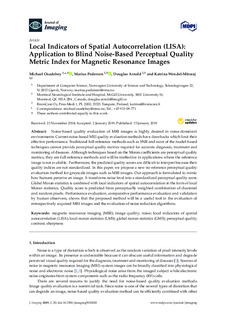Local Indicators of Spatial Autocorrelation (LISA): Application to Blind Noise-Based Perceptual Quality Metric Index for Magnetic Resonance Images
Journal article, Peer reviewed
Published version
Permanent lenke
http://hdl.handle.net/11250/2617497Utgivelsesdato
2019Metadata
Vis full innførselSamlinger
Sammendrag
Noise-based quality evaluation of MRI images is highly desired in noise-dominant environments. Current noise-based MRI quality evaluation methods have drawbacks which limit their effective performance. Traditional full-reference methods such as SNR and most of the model-based techniques cannot provide perceptual quality metrics required for accurate diagnosis, treatment and monitoring of diseases. Although techniques based on the Moran coefficients are perceptual quality metrics, they are full-reference methods and will be ineffective in applications where the reference image is not available. Furthermore, the predicted quality scores are difficult to interpret because their quality indices are not standardized. In this paper, we propose a new no-reference perceptual quality evaluation method for grayscale images such as MRI images. Our approach is formulated to mimic how humans perceive an image. It transforms noise level into a standardized perceptual quality score. Global Moran statistics is combined with local indicators of spatial autocorrelation in the form of local Moran statistics. Quality score is predicted from perceptually weighted combination of clustered and random pixels. Performance evaluation, comparative performance evaluation and validation by human observers, shows that the proposed method will be a useful tool in the evaluation of retrospectively acquired MRI images and the evaluation of noise reduction algorithms.
